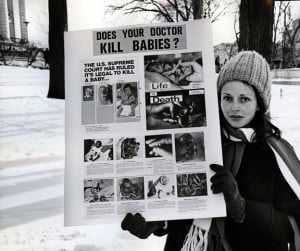6 Class Action Lawsuits that Changed U.S. History
What’s the first thing you think when you hear the terms “class action lawsuit”? If you’re like most Americans, you probably think of movies like A Civil Action, starring John Travolta as the lawyer who fought for years on behalf of the townspeople of Woburn, Mass., against Cryovac. You may also think of Erin Brockovich, starring Julia Roberts as the cleavage-baring legal assistant who helps residents of Hinkley, Calif., fight Pacific Gas & Electric.
And you’d be right. Class action lawsuits like these—also called “civil actions” because they’re argued in civil court—tend to get the most press because of the large sums of money awarded. But did you know that many Supreme Court decisions—ones that changed American history—originated as civil suits?
Class actions are lawsuits brought by a group or “class” of plaintiffs who have suffered the same or similar harm from a defendant’s actions; or they are suits where a class of defendants is being sued. Out of hundreds to choose from, we found 6 Class Action Lawsuits that Changed U.S History.
1. The State of Tennessee v. John Thomas Scopes
Also known as the “Scopes Monkey Trial,” this class action suit challenged the constitutionality of the Butler Act, a 1925 Tennessee law making it unlawful to deny the divine creation of man as written in the Bible and to teach instead the theory of evolution.
When the State of Tennessee passed the Butler Act, the American Civil Liberties Union (ACLU), in one of the organization’s earliest battles, asked for volunteers to deliberately teach Charles Darwin’s theories in a public Tennessee school room. They found their representative in biology teacher John T. Scopes, who agreed to teach the forbidden subject in his classroom. Scopes was indicted in May of 1925 and the trial kicked off in June of that same year.
The case would eventually be argued by several of the leading lawyers of the time, including Clarence Darrow for the defense, and William Jennings Bryan, former United States Secretary of State under Woodrow Wilson and an opponent of Darwinism, for the prosecution.
Although the trial raised awareness and acceptance of the theory of evolution and of academic freedom, the Butler Act would not be repealed in Tennessee until 1967 and nationally in 1968 after subsequent civil action lawsuits that challenged the laws again.
The ability to teach the theory of evolution in public schools continues to be challenged. In 1999, for example, the State Board of Education of Kansas struck evolution from the state’s teaching standards and textbooks.
2. Brown v. Board of Education of Topeka
Brown v. Board of Education of Topeka, the landmark decision that declared segregated or “separate but equal” schools unconstitutional, is hailed as a watershed moment in the civil rights movement and as one of the most important decisions of the U.S. Supreme Court.
In 1954 major sections of the U.S. had schools segregated along racial lines due to the 1896 Plessy v. Ferguson decision which permitted segregation at the state level as long as the separate schools were equal. Thurgood Marshall, who was appointed in 1967 as the first black justice to the Supreme Court, led the class action lawsuit for the plaintiffs.
The class action, a consolidation of five similar cases in four states, was eventually filed on behalf of Oliver Brown, the father of a child who was prevented from enrolling in a whites-only school in Topeka, Kansas. Brown claimed that the segregated school system in Topeka violated the Equal Protection Clause of the fourteenth amendment to the constitution because the black and while schools were not and never could be equal to each other. The Court, handing down its decision on May 17, 1954, agreed unanimously with Brown, with Chief Justice Earl Warren delivering the decision.
3. Roe v. Wade
Roe v. Wade, one of the most socially controversial and impactful pieces of legislation in the U.S., was a consolidation of three civil action lawsuits being argued in different states at the same time. The 1973 Supreme Court decision made abortion legal until the end of the first three months of pregnancy and declared that restricting a woman’s right to choose abortion was an invasion of her privacy, covered under the ninth and fourteenth amendments to the U.S. Constitution.
The decision, which struck down an 1851 Texas statute that criminalized abortion unless the life of the mother was in danger, came under immediate attack by opponents and still faces challenges at the state level to this day.
The representative plaintiff in the class action, Norma Harvey, who later identified herself as the “Roe” in Roe v. Wade, wanted to end her pregnancy but could not afford to travel to one of the other U.S. states that had already legalized abortion. After many years speaking as a champion of the 1973 decision, Harvey told the press in 1995 that she had changed her views about abortion and was now “pro-life.”
5. Lois E. Jenson v. Eveleth Taconite Co.
Lois E. Jenson v. Eveleth Taconite Co., filed in 1988, is notable for being the first sexual harassment class action lawsuit in U.S. history. The outcome of the case not only changed state and federal laws protecting workers but also set precedence for more class actions demanding an end to harassment and discrimination on the job.
The Jenson case, immortalized in the movie North Country, starring Charlize Theron, was filed on behalf of Lois Jenson and 14 other female mineworkers who were subjected to extreme physical harassment and intimidation at the hands of some of their male coworkers and supervisors at Taconite’s EVTAC mine in Eveleth, Minnesota.
After a decade of delaying tactics and hostile judges and on the eve of a jury trial, the suit was finally settled out of court, with EVTAC awarding monetary damages to all 15 women involved in the case.
5. Anderson v. Pacific Gas & Electric Co.
Anderson v. Pacific Gas & Electric Co., a civil action settlement dramatized in the film “Erin Brockovich,” starring Julia Roberts, is notable for being the largest civil settlement—$333 million—at the time the case was concluded in 1996.
The case, brought by the residents of the town of Hinkley, California, alleged that PG&E knowingly dumped wastewater contaminated with chromium-6, a known carcinogen since 1925, into the region’s groundwater. In addition to the monetary damages PG&E had to pay, the utility company was also required to clean up the contaminated groundwater and stop using chromium-6.
Controversy began to surround the civil action settlement almost from the moment it was settled when the legal team, who received 40% of the settlement, charged an additional $10 million in “expenses, leaving the 648 plaintiffs a total of $196 million or an average of only about $300,000 per victim.
The town of Hinkley was in the news again in 2011, when it was announced that the plume of chromium had been spreading since 2008. In November 2010, PG&E offered to purchase some of the houses and properties in the town as well as provide bottled water to residents, just as they’d done in the 1990s before the original class action.
6. Tobacco Master Settlement Agreement
As one of the largest civil class action lawsuit in U.S. history, the 1998 Tobacco Master Settlement Agreement, signed by the attorneys general of 46 U.S. states and representatives from the five largest cigarette manufacturers at the time, aimed to reduce smoking, particularly among young people. Since the agreement was signed in November 1998, approximately 40 additional tobacco companies have signed and agreed to the terms of the settlement.
The master settlement agreement introduced many sweeping changes, among them:
- Cigarette manufacturers agreed to make many internal documents available to the public.
- Cigarette manufacturers agreed to limit or cease altogether certain marketing and advertising practices, especially those that targeted children and youth.
- Cigarette manufacturers agreed to pay a minimum of $206 billion to the states as compensation for incurring large health-care costs. These monies were to be paid annually over 25 years.
The creation of education foundations, funded by the tobacco companies, aimed at reducing smoking among youth and educating the public about the dangers of smoking.
The terms of the civil action settlement agreement have been in the news again recently as several industry monitors have complained that the tobacco companies and the states are not living up to their end of the agreement. The Campaign for Tobacco-free Kids reports in its 2011 annual report that the signatory states have slashed their funding for programs aimed at stopping smoking to the lowest level since 1999, when they first received the settlement monies. The report goes on to say that states will spend less than two cents of each dollar they receive in tobacco revenue to stop tobacco use.
What do you think of our list? What’s missing? Feel free to add your favorite class action lawsuit that changed U.S. history.















